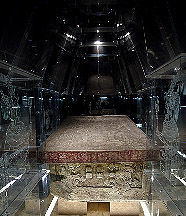Body Image
Maya and Egyptian Pyramids: A Hidden Connection?
An Egyptologist and a Mayanologist explore the pyramid connection.
Posted October 31, 2011 Reviewed by Abigail Fagan
Whenever I go south to Mexico, I marvel at the monumental stone structures, which reach toward heaven, that were left behind by the Maya. When I went to Egypt, I stood at the base of pyramids that point toward the sky and contemplated the cosmology of the Pharaonic civilization that built them.
Even though many centuries elapsed between the construction of the Egyptian and earliest Mexican pyramids, was there a connection between the two pyramid-building people, I wondered? Stories circulate about coca leaves found in Egyptian tombs, aliens bringing knowledge to both Egypt and the Maya, and even a common connection to Atlantis, but they seem to be just stories; there is no scientific evidence.
I decided to approach the question another way. I recently took a trip to Mexican ruins accompanied by a Mexican Mayanologist and archeologist named Yolanda Ruanova and Manal Saad, an Egyptian-born Egyptologist and historian. "Is there a connection?" I asked them.
Yolanda, who is a well-known and much-esteemed tour operator and guide, planned the trip for us. We started out at Comalcalco, in Villahermosa, where the special characteristic of the Maya site is that cooked bricks were used in the construction. They were covered in stucco made from clay and oyster shells, and the shells were also used in the binding of the bricks.
We climbed up to the main palace. "Wow!" Manal exclaimed. I thought she was referring to the porch, vaulted ceilings, and circular walls that Yolanda showed us, but she was overcome by the lush, tropical foliage around the site. "The Egyptians built in the desert," she mused. "This is so green! In Dendra, north of Luxor, there is a temple for the cow goddess Hathor. It is the only temple in good enough condition that you walk on it. You look out and see the desert, the dust, and then, in the distance, the green banks of the Nile. Being here reminds me of that green."

Then, of course, she spoke about the archeology. "The palace is fascinating," she offered. "Ramses III had a palace on the West Bank of the Nile that was similar. Both of them are built close to holy places and temples." As we climbed down to look at the images and figures on the exterior of the Temple of the Masks, Manal stopped and pointed. "This face looks like the Egyptian god Bes; his face was put on the two sides of a headrest to chase away bad dreams. This was just one of his characteristics. He was the only Egyptian god who was carved full-face, just as we are seeing here."
"I think that the two cultures had a lot in common," Yolanda said. "How is it possible that people who lived at different times and so far away can have so many things in common? Humans always have the same needs—they need to believe in something, create gods, have rain and sun, all of which give them life. They give different names to gods, but they are the same. The Maya and the Egyptians had good architects, priests, technologists." Then she and Manal exchanged knowing professional glances. "But there is no proof for contact," they said.
When we arrived at Parque Museo de la Venta, an Olmec archeological site in Villahermosa, Tabasco, there were no Maya ruins, but we stared, in unison, at the huge stone heads constructed during the pre-Classic period, which began about 3,700 years ago and went to the second century B.C.E. The Olmecs are generally considered to be the "mother culture" of Mesoamerican civilizations. The heads seemed like they had African features such as full lips and broad noses.
"One of my archeology colleagues felt that the heads were stylized by the Olmecs to look like jaguars," Yolanda said.
Hmmm, I mused. We walked around Parque Museo de La Venta, visiting the rich collection of living jungle animals, and stopped in front of the jaguar habitat. Those jaguars had thin lips. No stylization of a jaguar would result in broad noses and plump lips. Did some Africans travel to Mexico a long time ago? Egypt, after all, is mostly in north Africa.

Last year there was a startling find at Stonehenge in Britain: the body of a teenage boy who arrived from the Mediterranean 3,500 years ago in a wooden boat. People have always traveled. It may have taken them longer, but they traveled huge distances by land and sea. Why would contact between the Olmecs and Africa or the Maya and Egyptians—or people who had been to Egypt and seen the pyramids and stone carvings—be impossible?
From about 300 B.C.E. to 300 C.E., there was an Egypt-inspired pyramid revival in what is today Sudan, in Africa, and the pyramids had a decidedly indigenous spin. How far-fetched was it to think that African travelers to Mexico introduced the idea or the technology of pyramids, and the locals gave their pyramids an indigenous spin too?
"The Olmecs built pyramids, but with mud. That's why they are destroyed, and not well-preserved," Yolanda said.
"Well," I mused, "the Egyptians started out with experimentation too. These Olmec heads have African features. People traveled the great waterways of the world for thousands of years. Why wasn't contact possible?"
"To this day the meaning of the Olmec heads remains uncertain," Yolanda explained. "Because of the facial features, a lot of people have suggested that the Olmecs came from another continent to populate the Gulf Coast, but all the archaeological research in the nuclear area indicates that they are Mesoamerica natives so the features must be explained otherwise."
"But isn't it possible that they haven't yet found proof in the nuclear area, or the proof lies elsewhere?" I asked. Manal and Yolanda shook their heads. No concrete proof, therefore no provable contact.
At the site and in the museum, Manal was scrutinizing the stone stelae. "The Egyptian stelae were bulkier, but they were basically the same idea-writing and carving on stone. In Egypt, a son could offer a stone to his parents, or to mark the birth of a new baby."
"For the Maya, they represented rulers or the history of rulers. And also wars and special events, like the birth of a royal baby," Yolanda said.
"Some of the figures here have animal heads and human bodies. Like Horus, the falcon god. And look at this carving called ‘The Walker,' Manal offered. "The pharaohs always had their left foot forward, to show action and movement. Just like The Walker."
"Oh, wow, look at this!" I exclaimed as we stood in front of the Altar of the Children. "There are images of four men, and each is carrying a child. They remind me of the stelae I saw in Carthage, where a priest carries a child to be sacrificed. And where is Carthage? In Tunisia, in North Africa."
The women looked quizzically at each other.
Palenque, which emerges dramatically from the jungle, is one of the most celebrated sites from the ancient Maya world. "There is a lot of history here. Breathe deeply. You will feel the energy," Yolanda said. Manal and I breathed. We could feel it. Manal stood at the base of a huge pyramid and quietly said, "It's like you are looking at the plan of an Egyptian pyramid upside down. The burial chamber is close to the top of our pyramids. Here is it at ground level or below. And in the chambers, we found amazing riches associated with burials, like the gold mask of Tutankhamen."
"Here they found the jade mask of the ruler Pacal," Yolanda said. She led us to a room in the Palenque museum that housed an exact replica of Pacal's tomb.

Manal stared at a carved, full-body image of Pacal. Around his neck, she saw an elaborate collar. "It's like the collar the pharaohs wore," she observed.
We climbed up to the elaborate and extensive royal palace. "The terraces and levels and corridors or porches remind me of Hatshepsut's tomb," Manal mused. Once again, she looked at the tropical foliage, the greenery surrounding the site. "The Egyptians buried pharaohs in the desert because—we think—the dryness would preserve the bodies. We never had this kind of fertility. At least we don't think we had it. But who knows?"
Yolanda pointed out the individuality of the figures carved by the ancient Maya and asked Manal if the same was true in Egypt. "The images of the pharaohs were stylized," she replied. "Here they feel so unique you think they are ready to speak. They are almost alive."
I have always wanted to see the famous murals at Bonampak, and Yolanda took us there.
Large, brilliantly-colored images of gods, the famed leader Chan Muan, nobles, a procession, musicians, war, priests, and prisoners adorn the walls of three rooms. Overcome by the beauty and power of the murals, Manal asked, "What colors did they use? Maybe they were of a higher quality than what the Egyptians used. Ours were preserved by the dry climate, but these have survived so vividly in a wet, humid, difficult climate."
After Bonampak, Manal had to leave our private tour, and she and Yolanda hugged goodbye. As I continued on with Yolanda to other ruins and other sites, I understood that both she and Manal were fired up by questions raised when they were together. But, understandingly, with their formal training, they were cautious about stating that there were any historical connections without visible, tangible proof.
"Who knows?" they quietly conceded before they parted. "Who knows?"




